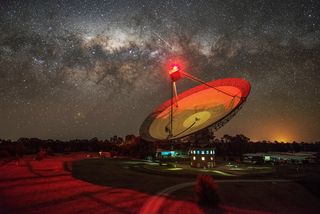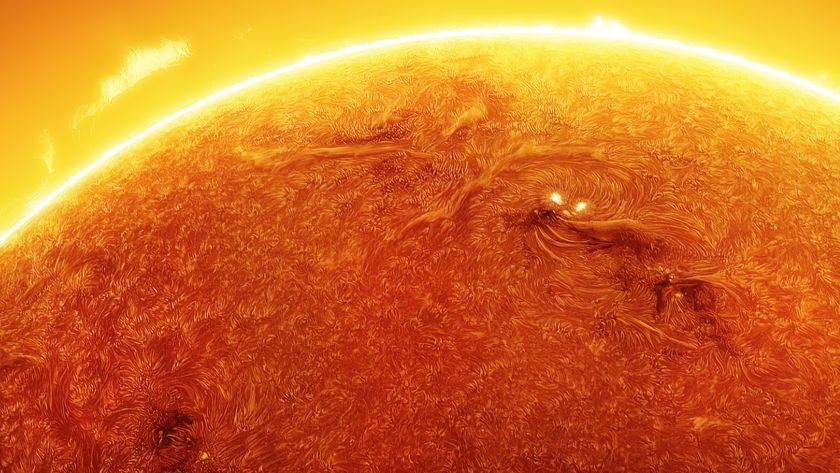Sorry folks: 'Alien' signal from Proxima Centauri was likely just a broken computer on Earth
The call was coming from inside our solar system all along.

A strange radio signal once thought to be a possible sign of alien intelligence in a nearby star system was likely created by a broken piece of human technology, according to new research.
On April 29, 2019, astronomers detected a signal beaming toward Earth, it seemed, from Proxima Centauri — the nearest star system to our sun (at about 4.2 light-years away) and home to at least one potentially habitable planet. Because the signal fell into a narrow band of 982 MHz radio waves that are rarely made by human aircraft or satellites, researchers interpreted it as a possible sign of alien technology.
However, the signal — which lasted for about five hours — never reappeared during subsequent scans of Proxima Centauri. The reason, according to two new studies published Oct. 25 in the journal Nature Astronomy, is likely because the signal wasn't coming from Proxima Centauri at all.
To put it in Halloween-y terms: The call was coming from inside the solar system.
"It is human-made radio interference from some technology, probably on the surface of the Earth," Sofia Sheikh, an astronomer at the University of California, Berkeley, and a co-author of both papers, told Nature.com.
Related: 7 things most often mistaken for UFOs

In the first of the two new studies, Sheikh and her colleagues describe the signal — dubbed BLC1 — in detail. Astronomers picked up the five-hour-long flurry of radio waves with the Parkes Murriyang radio telescope in southeastern Australia during a 26-hour-long survey of Proxima Centauri. The survey was part of an ongoing $100 million alien-hunting program called Breakthrough Listen, which uses telescopes around the world to listen for possible extraterrestrial transmissions.
Sign up for the Live Science daily newsletter now
Get the world’s most fascinating discoveries delivered straight to your inbox.
The telescope recorded more than 4 million radio signals from the vicinity of Proxima Centauri during that observation window, but only BLC1 struck astronomers as unusual, both for its lengthy duration and its peculiar wavelength. The team quickly ruled out interference from satellites or other human aircraft.
After the signal failed to reappear in subsequent observations of the star, however, the researchers took a closer look at their initial data. This time, they found that their automated sorting program had previously overlooked several signals that looked very similar to BLC1 but emitted at different frequencies.
In the second of the two new Nature papers, the researchers concluded that BLC1 and those "lookalike" signals were components of the same radio source; and that radio source was likely something on the surface of Earth, somewhere within a few hundred miles of the Parkes Murriyang telescope. That the signal appeared only during that five-hour observation of Proxima Centauri is probably just a coincidence, the team said.
Because the signal never reappeared, it's possible that it was coming from a piece of malfunctioning electronic equipment that either got shut down or was being repaired, Sheikh told Nature. The range of frequencies within the signal was also "consistent with common clock oscillator frequencies used in digital electronics," the researchers wrote — suggesting that a nearby phone or computer on the fritz might have produced the "alien" signal. The team is planning subsequent studies to figure out just what the source could have been.
This isn't the first time a banal piece of human technology has been caught masquerading as alien hardware: One famous set of "alien" signals detected between 2011 and 2014 turned out to be scientists microwaving their lunches. However, BLC1 was the first candidate signal detected though the Breakthrough Listen program, and the nearly year-long analysis that followed provided researchers with valuable experience in decoding "alien" emissions.
"It's really valuable for us to have these dry runs," Jason Wright, an astronomer at Pennsylvania State University who was not involved in the studies, told Nature. "We need these candidate signals so we can learn how we will deal with them — how to prove they are extraterrestrial or human-made."
Originally published on Live Science.

Brandon is the space/physics editor at Live Science. His writing has appeared in The Washington Post, Reader's Digest, CBS.com, the Richard Dawkins Foundation website and other outlets. He holds a bachelor's degree in creative writing from the University of Arizona, with minors in journalism and media arts. He enjoys writing most about space, geoscience and the mysteries of the universe.












